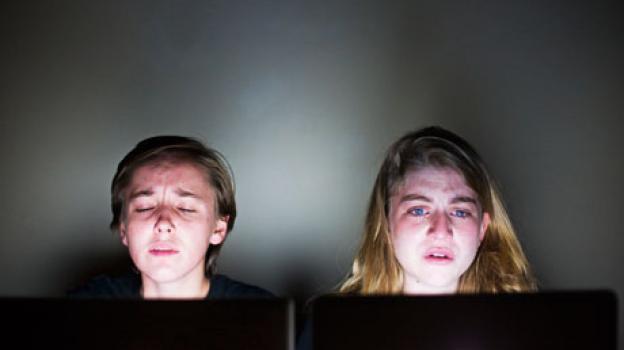Two girls with laptops at a table, upstage. The content of each screen is projected side-by-side behind them onto the rear wall. The images we see are of two tear-stained faces – a whole slideshow of them. It goes from photos to real-time videoing, and we see the tears really falling. This moves into footage of famous tear-jerking film moments, from Bambi to Titanic – some amusing, some disturbing. Every genre of film and TV is touched on, from horror to thriller to soppy romance to soap opera. The girls are now on the floor downstage, playing out the scenes – death-bed scenes and murder scenes and child-hugging scenes – to and with each other, synching their live words to the relayed screen images, and joining in the crying and howling and comforting. There are bad wigs and a few props, and it is all both ludicrous and strangely touching: I’m reminded of Forced Entertainment’s And on the Thousandth Night in this ironic telling of so many stories upon stories upon stories.
It strikes me that it’s the girl equivalent of playing Pokemon or superheroes or Power Rangers. I’m reminded of my own sons’ acting-out games when younger, and of a marvellous moment in Martin Amis’ novel The Informationwhen he perfectly captures boys role-playing: ‘I want to be the blue Power Ranger!’ ‘No. I’m the blue Power Ranger!’
I’m also remembering being 16 and practising frowning and crying to the mirror: How will I look when the newspapers photograph me if I suddenly find out that both my parents were killed in a plane crash? I’d forgotten that till now… So this is the 21st Century version of the faces-in-the-mirror alone-in-your-bedroom game. It’s a girl thing, a modern girl thing.
In their programme notes, the show’s creator-performers Nathalie Marie Verbeke and Charlotte De Bruyne – who came to fame as teenagers starring in Ontroerend Goed’s Once And For All We Are Going To Tell You Who We Are So Shut Up And Listen – explain that the starting point for XXXO came from discovering that they had both filmed themselves crying, and that many of their friends had confessed to doing the same. It kick-started an artistic investigation of what makes us cry, and of how this generation of young people are responding to the constant bombardment day and night with images of grief – real and fictional – in media of all sorts. How to know when grief is real? How to feel real grief? When are crocodile tears as therapeutic as real tears, and are there different sorts of tears anyway? My train of thought moves into: Why did I cry when Lady Di died and stay stony-faced at my own mother’s funeral? As Camus pointed out, we are willing to persecute someone who does not cry when they are ‘supposed to’ – crying is expected. Use onions if necessary to bring on the tears (and they do).
The screens switch to projected play texts, and we see our heroines acting out Medea’s despair and rage at the point when she decides to kill her children to exact revenge on her erring husband: ‘Let no man say of Medea that she is mild as milk.’ We move into a montage of clips from YouTube: everything from Nessun Dorma to lost penguins in the wild to newborn babies first cries, via car crashes, bomb blasts and desperate last phone calls from the struck towers of the World Trade Centre. Oh, life! Oh, death! Remember, these young women would have been nine or ten years old when 9/11 happened, would have seen it all played out on TV. They will have seen the Gulf War footage and torture and slaughter from all across the world played out on their computer screens night and day. They would have had access to all sorts of horror, real and imagined, throughout all their growing years. They will have surreptitiously watched all sorts of things on YouTube that their parents wouldn’t have wanted them to see. How does that affect you? How do you deal with all this pain, all these tears?
Children have always coped with distress and terror and grief by acting out what they’ve witnessed in their play. Adults do the same, but they call it making plays rather than play. As young theatre-makers only recently arrived at adulthood, these two have created an exciting and imaginative piece of work that sits between ‘play’ and ‘a play’. It’s courageous and disturbing and funny and curious, all at once.
There are dissenters. A friend (who disliked the show) described it as ‘a Marmite show’ – love it or hate it – and I am sure that there are many people who, like him, wonder who the audience is for this sort of work. It is not an obvious crowd-pleaser, and I feel that placing it in the home-of-the-jolly-romp Pleasance Courtyard is really not the right decision for the company. The gloomy cavernous space feels completely wrong for the show, and the black curtain backdrop means that the projections are murky and hard to make out at times. I do feel British audiences are open to this sort of experimental theatre-making – but how, when and where such work is presented is a key issue.
Regardless of these production issues, and the problem of targeting the right audience, a great debut from two young women who have grown up with Ontroerend Goed and have now set off on their own path as theatre-makers. I eagerly await whatever they decide to do next, together or alone.


